Review and photos by Patrx, edited by Suspsy
Deinonychus is kind of a big deal. Its inescapably bird-like skeleton is part of what led paleontologists of the early 1970s to re-examine old ideas about the origin of birds, and the nature of dinosaurs as a group. Everything from dinosaur metabolism to their family dynamics and brainpower was up for reinterpretation. We call this revolution the “dinosaur renaissance,” and paleoart of Deinonychus helped bring these ideas to the public. Robert Bakker’s ’69 drawing of the animal in full sprint is iconic, and arguably the very first mass-produced feathered dinosaur figure was a reconstruction of Deinonychus. Jurassic Park brought Deinonychus to the masses under the name Velociraptor. Swift of mind and warm of blood, these cinematic stars were nothing short of inspiring for young dinosaur maniacs like me. But alas, this strong impression would prove to be a mixed blessing going forward. I started collecting dinosaurs in 2009, after a beautiful painting of a feathery Deinonychus by John Conway made me realize just how much things had changed—another revolution was underway. I immediately tried to find the most modern figure of the animal available, but discovered that Deinonychus was frozen in time once again. So, I waited. Maybe you did, too. Until today!
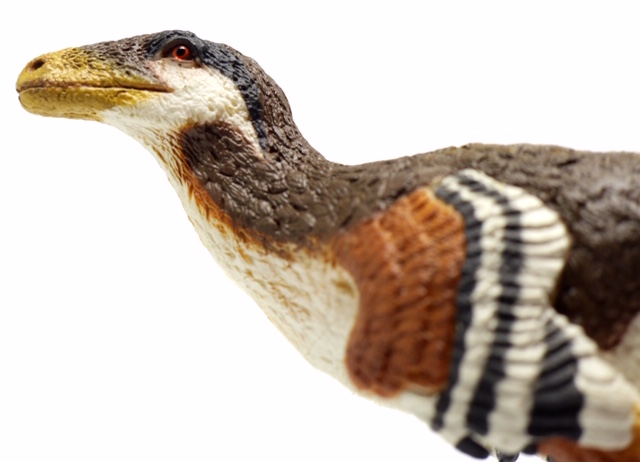
The new Deinonychus from Safari Ltd. measures approximately 22 cm in length, making it about 1:14 scale. Like a modern bird, its feathers give it an elegant silhouette, obscuring the reptilian body in a sleek “shell.” This immediately sets it apart from other feathered dromaeosaur toys, which generally look like old reconstructions with half-random feathers added on. The detail here is impressive, showing feathers of varying types and lengths. Shaggy feathers cover the legs, down to the raptorial feet. Shorter fuzz covers much of the face, and even the digits on the wings. This addresses a minor issue I took with Safari’s recent Velociraptor figure; maniraptoran hands were probably feathery, just like the rest of the wing. The longest remiges, or wing feathers, appear to appropriately connect to the middle digit of each hand. The wings themselves are folded neatly, with the hooked claws pointing inward. This degree of wing-folding is certainly plausible for Deinonychus, and, to my eye, looks much more natural than the dangling, extended posture more typical in figures like this.
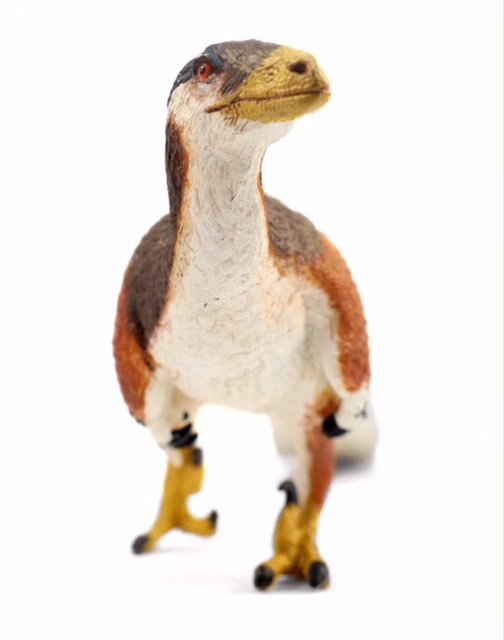
In fact, this figure’s pose is altogether splendid: alert, but calm. This Deinonychus is striding forward, with its head pointed just to the right. Its mouth is closed, with its teeth protected by “lips”—another improvement on the Velociraptor. The tail is arched gently downward so that the very end touches the ground. The toy balances in this way, but the effect is not so distracting as it is in most “tripod” figures, like many Carnegie theropods. The long rectrices, or tail feathers, seem to subtly weigh the tail down. If this dinosaur decided to run, one can easily imagine, the end of the tail would lift off the ground to provide counterbalance. The eumelanin, or dark pigmentation, illustrated on the ends of these rectrices would have made them a little more resistant to wear, as we see in many modern birds.
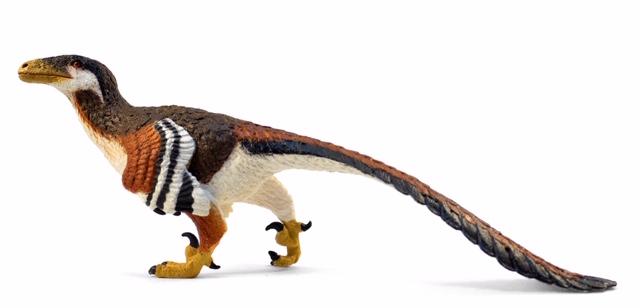
The rest of the coloration chosen here seems natural, too. Some inspiration, perhaps, from extant predatory birds, but not direct mimicry. Countershading in white and brown, some reddish pigment here and there, a black “mask” behind the eyes, and a few black bands bring the feathers to life, and the skin of the face and feet has a yellow-orange hue that’s kept from looking overly vibrant by the subtle use of a dark wash. The eyes on this piece really impress me. From early in-hand photos, I thought they might be separate pieces of translucent red plastic, but in fact, the effect is accomplished simply with a glossy red paint and very tidy black pupils.
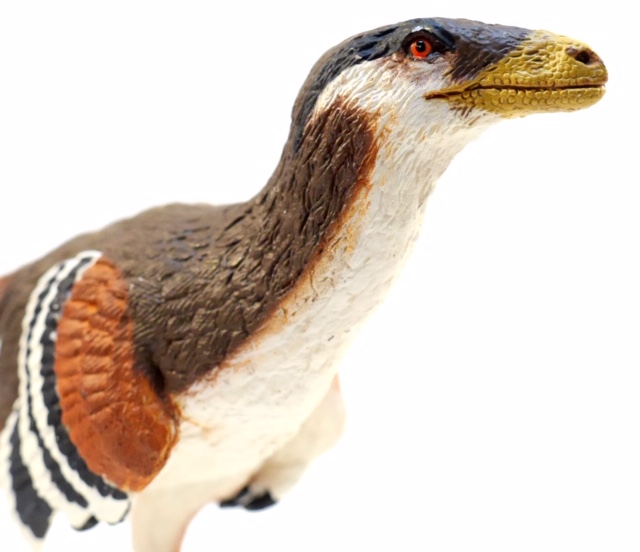
Typically, I try to find something to add to my reviews that doesn’t read like overjoyed raving—a small nitpick, some minor matter of personal preference. After all, I want to keep things fair. But this one’s tough to complain about, folks. Even its claws, which Safari usually round out dramatically for safety reasons, are relatively sharp. My copy does have a bit of in-shipping damage in the form of slightly scuffed paint and a warped toe, but both of those are pretty easy fixes and not especially reflective of the figure itself.

Honestly, if you’ve an interest in dromaeosaurs, or even just the history of paleoart, I gotta recommend this piece one-hundred percent. Kudos to sculptor Doug Watson and the rest of the team at Safari Ltd!
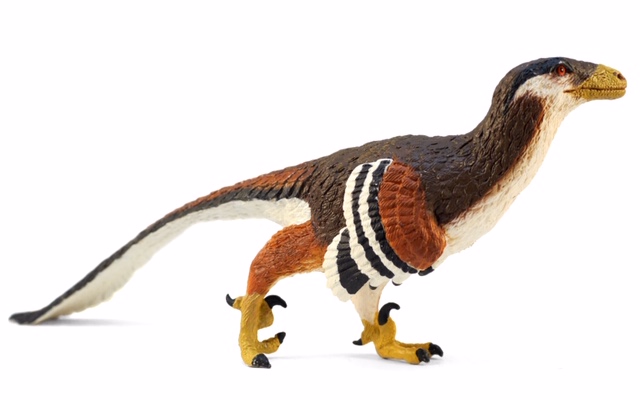
This figure is available from Ebay.com here.
Disclaimer: links to Ebay and Amazon on the DinoToyBlog are affiliate links, so we make a small commission if you use them. Thanks for supporting us!




“Swift of mind, warm of blood” would be an excellent title for something. Great review!
It’s great to finally see a Deinonychus portrayed as a majestic animal rather than a Jurassic Park-esk movie monster.
Excellent review of an excellent figure. Amazing work from Doug.
I was actually a little on the fence about this figure until I read this review and saw the finished product. Excellent figure and I’m very keen to get one of my own as soon as possible. Great review as well.
I think Doug Watson’s velociraptor was better but this reminds me of All yesterdays
Wonderful review, and a wonderful figure as well. I really enjoyed reading this one, and I”m hoping I can get my hands on this figure soon enough. I’ve waited years for this. Now let’s hope Utahraptor can join this one and the Velociraptor some day.
Great resources, Sim! Thanks for the addenda 🙂
Regarding the hands and fingers, as was discussed on the following link, Anchiornis had fingers that were feathered on top and scaly on the underside: http://dinotoyblog.com/forum/index.php?topic=5526.msg166665#msg166665
Personally, I think scaly fingers like on the Velociraptor and feathered fingers like on the Deinonychus are both plausible for these animals, as is feathered on top and scaly on the bottom like in Anchiornis.
This Deinonychus and Safari’s 2017 Velociraptor are both excellent figures, and I’m very happy to have both! I hope in the future Safari makes a Saurornithoides (there’s a lack of good troodontid figures) and a Utahraptor (no figure represents Utahraptor the way it’s now known to look).
Thank you
Lovely review. I share your enthusiasm. It is a truly magnificent figure. Doug Watson outdid himself, once again.
The definitive Deinonychus, at least for now!
It is a detailed figure, the feathers are carefully sculpted one by one. And what I like most about this figure is that its fierce appearance is glimpsed without having your mouth open. It is one hundred percent scientific. I congratulate you on your review and your article is masterful.